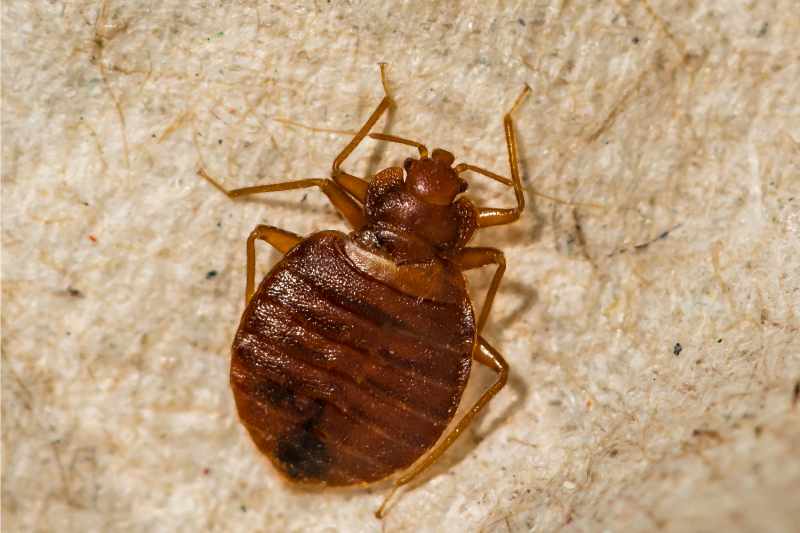
Our frigid Minnesota winters allow lots of time for snuggling up indoors while the snow falls outside. But we’re not the only ones searching for warmth. An array of biting and stinging insects also follow the heat.
Some of these pests carry disease while others are merely a nuisance. Being aware of them is the key to protecting yourself. The following guide is the worst of the worst stinging and biting pests in Minneapolis.
Bed Bugs

Not all nasty biting bugs live outdoors. Except when they “hitchhike” in human belongings to new locales, bed bugs are exclusively indoor pests. While they do not transmit disease, they do feed on human blood to reproduce. That means it’s important to nip any infestation in the bud.
Frequent travelers are the most likely to bring home these nasty pests. It is possible to avoid them with a few checks whenever you sleep away from home.
- Check the bed frame and box spring before you unpack your bags. Check for any sign of the flat, brown insects, and do not stay in any place that shows signs!
- If you spot any sign of bed bugs in your luggage, seal everything in plastic bags until they can be heated, frozen, or laundered.
- If you bring them home, hire a professional to exterminate them immediately.
Biting Flies

Horseflies and deerflies reproduce in wet, marshy areas but can travel miles away to prey on unsuspecting victims. Their bite carries a stinging punch, but they do not transmit diseases. A repellent containing the chemical Deet is the most effective defense, but lemon eucalyptus oil (OLE) is also an effective natural fly repellent.
Black flies (also known as gnats or buffalo gnats) are another story altogether. They mount their attacks during dawn, dusk, and overcast days, biting around the hairline and ears. Unfortunately, repellents are not effective against black flies.
The best way to prevent bites from black flies is to avoid the outdoors during their active times and wear clothes that cover bare skin to deter them.
Blacklegged Ticks

Photo Credit: Lennart Tange / Flickr / CC BY 2.0.

This is the second nastiest biting insect in terms of potential danger. Blacklegged ticks, or deer ticks, are responsible for transmitting Lyme disease, anaplasmosis, babesiosis, and a form of encephalitis.
Jeff Hahn is an entomologist at the University of Minnesota Extension. He cautions, “Blacklegged are potentially active year-round, down to the mid-30s. They won’t be as active in cooler months, but the potential is still there.”
He says the highest numbers of tick-borne infections occur in June and July. The ticks aren’t more toxic then, but the nymphs are more active and harder to detect than adult ticks.
Nymphs can be very tiny, so it’s important to check your skin after outdoor activities. To prevent tick bites, use a repellent with Deet and permethrin. Spray it onto your clothing and let it dry overnight. Tuck pants into socks, and don’t forget to do a full-body tick check as soon as you come inside.
Ticks need to be attached to your body from 12 to 24 hours to transmit disease. If a tick bites you, remove it, and send it to the Minnesota Department of Public Health for identification. The department maps out the areas of the state where you’re likely to find these pests.
Mosquitoes

They may be small, but mosquitoes are the deadliest creature on Earth. When you’re hunkered down in winter, plotting your spring garden, it’s easy to forget you won’t be gardening alone. As soon as the weather warms, mosquitoes make their appearance.
The most-common mosquito in Minnesota is the Western encephalytis (Culex tarsalis) mosquito, pictured above. They also carry deadly diseases. Worldwide, they’re responsible for 830,000 deaths a year, transmitting everything from the Zika virus to dengue fever.
In Minnesota, they’re more likely to transmit West Nile virus and Jamestown Canyon virus.
To avoid mosquito issues, first, ensure you aren’t breeding mosquitoes in your own yard. Drain any containers holding standing water, clean your gutters, and trim back overgrown hedges. Personal protection is the most foolproof way to ward off these critters. Cover up with long sleeves and pants and wearing repellent is the best way to keep the mosquitoes away.
Yellow Jackets

Warmer temperatures also bring an increase in the numbers of yellow jacket wasps. You’ll find their nests almost anywhere, from shrubs to house eves or even buried in the ground. While generally non-aggressive, if their nests are disturbed they will attack. What’s more, unlike bees, they can sting multiple times.
Take care and wear gloves when pruning shrubs, in case there’s a nest tucked out of sight. For out-of-the-way nests that are unlikely to be disturbed, you may want to let them be.
But if you or a family member is allergic to wasps, you’ll want to get rid of any nests you come across by using a spray designed for wasps and hornets.
Spray for yellow jackets in the evening when they’re less likely to come after you.
Despite this list, Minneapolis is not a hotbed of disease-carrying biting insect activity. In fact, it is a relatively low-key spot when it comes to biting and stinging insects. If you take a few simple precautions, there’s no reason why you can’t enjoy a sting and bite-free life here.
Main Image Credit: 13651447 / Canva Pro / License